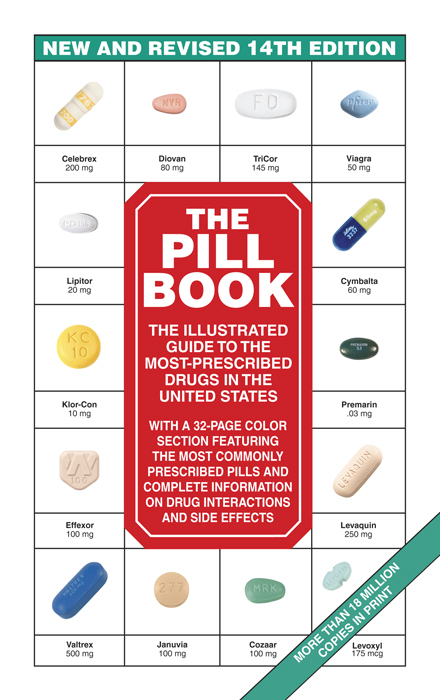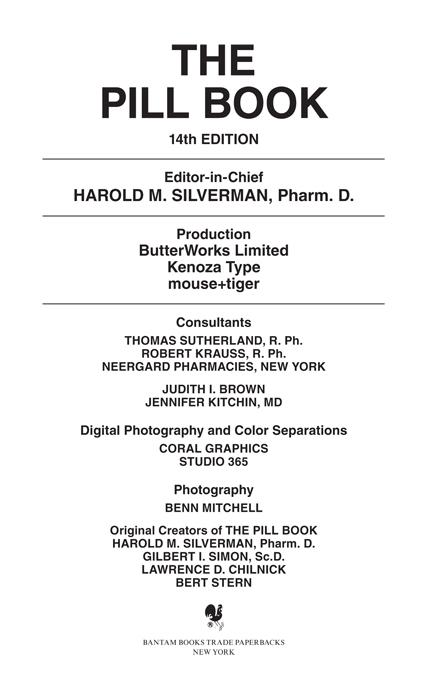THE PILL BOOK, 14th REVISED EDITION:
THE ILLUSTRATED GUIDE TO THE MOST
PRESCRIBED DRUGS IN THE UNITED STATES
Illustrated with color photographs
With more than 18 million copies in print, The Pill Book is the bestselling consumer drug reference ever, offering the most up-to-date, comprehensive information in a newly redesigned format that is even easier to use.
This new 14th edition of The Pill Book contains more profiles of commonly prescribed drugs than any other consumer reference. Compiled by a team of eminent pharmacologists, it is based on official, FDA-approved information usually available only to doctors and pharmacists, plus the latest information gathered from computer databases and online resources. It synthesizes the most important facts about each drug in a concise, readable, easy-to-understand entry.
Here are complete profiles on more than 1800 of the most commonly prescribed drugs, including:
- Generic and brand names
- What the drug is for and how it works
- Usual dosages, and what to do if a dose is skipped
- Side effects and possible adverse reactions, highlighted for quick reference
- Interactions with other drugs and foods
- Alcohol-free and sugar-free medications
- The most popular self-injected medications and their safe handling
- Information for seniors, pregnant and breast-feeding women, and others with special needs
This completely revised and updated 14th edition contains dozens of new brand names and more than 20 important new drugs recently approved by the FDA now on sale for the first time.
Create your own medical library with Bantam Medical Reference Books
Prescription Drugs for Half Price or Less
The Pill Book Guide to Natural Medicines
The Vitamin Book
The Bantam Medical Dictionary
The Doctors Book of Home Remedies
A Bantam Books Trade Paperback Original
Copyright 1979, 1982, 1986, by The Pill Book Company, Inc.
New information copyright 1990, 1992, 1994, 1996, 1998, 2000, 2002, 2004, 2006, 2008, 2010 by Bantam Books.
Cover art 2010 by Bantam Books.
All rights reserved.
Published in the United States by Bantam Books, an imprint of The Random House Publishing Group, a division of Random House, Inc., New York.
B ANTAM B OOKS and the rooster colophon are registered trademarks of Random House, Inc.
Previous editions of this book were published by Bantam Books in 1979, 1982, 1986, 1990, 1992, 1994, 1996, 1998, 2000, 2002, 2004, 2006, and 2008. This fourteenth revised edition is published simultaneously in trade paperback and mass market paperback.
In Canada Aspirin is a registered trademark owned by Sterling Winthrop Inc.
eISBN: 978-0-553-90763-6
www.bantamdell.com
v.3.1
Contents
The purpose of this book is to provide educational information to the public concerning the majority of various types of prescription drugs that are currently used by licensed health care professionals. It is not intended to be complete or exhaustive or in any respect a substitute for personal medical care. Only a licensed health care professional may prescribe these drugs and their exact dosages.
The images in this book do not correspond precisely with the actual pills, either in color or size. Furthermore, pictures identified as brand-name drugs should not be confused with their generic counterparts. In any event, the reader should not rely solely upon the photographic image to identify any pills depicted herein, but should rely upon the licensed health care professionals prescription as dispensed by the pharmacist.
How to Use This Book
How to Find Your Medication in The Pill Book
- The Pill Book lists most medications in alphabetic order by generic name because a medication may have many brand names but has only 1 generic name. Most generic medications produce the same therapeutic effects as their brand-name equivalents but are much less expensive. Drugs that are available generically are indicated by the
 symbol.
symbol. - When a medication has 2 or more active ingredients, it is listed by the most widely known brand name. In some cases, pill profiles are listed by drug type (e.g., Sulfonylurea Antidiabetes Drugs).
- The Pill Book includes the names of the top 100 brand-name drugs (cross-referenced to their generic name) in alphabetic order with the pill profiles.
- Most over-the-counter (OTC) medications are not included in The Pill Book. For complete information on OTC medications, refer to The Pill Book Guide to Over-the-Counter Medications.
- All brand and generic names are listed in the Index. Brand names are indicated by boldface.
- Sugar-free and alcohol-free brand-name drugs are indicated by the
 and
and  symbols in the beginning of each pill profile.
symbols in the beginning of each pill profile.
The Pill Book, like pills themselves, should be used with caution. Viewed properly, this book may save you money and, perhaps, your life. It contains life-size pictures of the most prescribed brand-name drugs in the U.S. The Pill Books product identification system is designed to help you check that the medication you are about to take is the one your doctor prescribed. Although many dosage forms are included, not all available forms and strengths of every medication have been shown. While every effort has been made to create accurate photographic reproductions of the products, some variations in size or color may be expected as a result of the printing process. Do not rely solely on the photographic images to identify your pills; check with your pharmacist if you have any product identification questions.
Each pill profile in The Pill Book contains the following information:
Generic and Brand Name: The generic name is the common name of the drug approved by the Food and Drug Administration (FDA). It is listed along with the current brand names available for each generic drug. Medications that are available in a generic form are indicated by the  symbol.
symbol.
Most prescription drugs are sold in more than one dosage strength. Also, some drugs, such as oral contraceptives, come in packages containing different numbers of pills. A few manufacturers indicate these variations by adding letters or numbers to the basic drug name; for example, Loestrin 21 1.5/30 and Loestrin 21 1/20. (The numbers here refer to the number of tablets in each monthly packet, 21, and the amount of medication found in the tablets.) Other drugs come in different strengths: This is often indicated by a notation such as DS (double strength) or Forte (stronger).
The Pill Book lists generic and brand names together only where there are no differences in basic ingredients (e.g., Loestrin). However, the amount of the ingredient may vary from product to product. In most cases, the brand names and generic versions listed for each medication are interchangeable; you can use any version of the drug and expect that it will work for you.









 symbol.
symbol. and
and  symbols in the beginning of each pill profile.
symbols in the beginning of each pill profile.